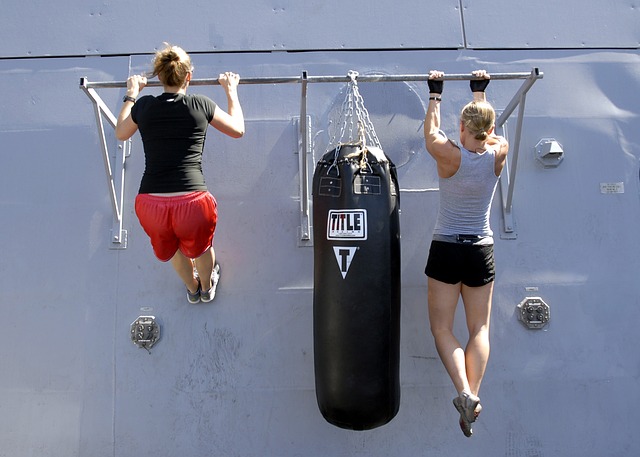When it comes to performing pullups as a beginner, it can be extremely challenging.
However, the great thing is that there are many techniques out there that have been discovered to make it that much easier for you to do pull-ups.
In this ultimate beginner’s guide to pullups, you will learn how to build yourself up to do your first pull-up, discover why they’re such a challenging exercise, muscles involved, proper programming and much much more!
Let’s get to it!
Why Pullups are so Challenging?
Any exercise that involves you to go against gravity will be challenging because the forces are pushing you down. This is truer when it comes to bodyweight exercises, but especially pull-ups. Pulling your own weight up requires an immense amount of strength and the feat of performing even one pull-up should be celebrated.
Below are some other factors that make it challenging:
- Arm Length
- Your Weight
- Overall Strength
What Muscles Get Worked?
Below are the following muscles that get worked during pull-ups:
- Biceps (Bicep brachii, brachialis, brachioradialis)
- Forearms (Flexor carpi radialis, flexor carpi ulnaris, palmaris longus, flexor digitorum profundus, flexor digitorum superficialis, and flexor pollicis longus)
- Back (Lattisimus Dorsi aka lats, trapezius, and rhomboids)
- Core (Rectus Abdomonis and obliques)
Does the Grip You Use Matter During Pullups?
The grip you use will affect what muscles get worked. A supinated grip (hands facing you) will target different parts of the body vs. a pronated grip (hands facing away from you.)
Let’s go over what muscles get worked during both grips here (besides forearms.)
Supinated:
- Lattisimus Dorsi (Back)
- Rhomboids (Back)
- Upper/Mid Trapezius (Back)
- Teres Major (Scapula)
- Bicep Brachii (Biceps)
- Brachialis (Biceps)
- Brachioradialis (Biceps)
The supinated grip pull-up is often called the chin up. At the end of the day, it does not matter what its called because you are pulling yourself up, but just in a different way.
Pronated:
- Lattisimus Dorsi (Back)
- Rhomboids (Back)
- Upper/Mid Trapezius (Back)
- Brachialis (Biceps)
- Brachioradialis (Biceps)
Some people tend to find a pronated grip a bit harder when they perform pullups. This could be due to your bicep brachii not being involved in the pronated grip pullup
How Should I Attempt My First Pull-up?
There are 3 ways you can start performing pullups as a beginner before you do one on your own. The 3 ways are negatives, assisted with the machine and banded. Typically when you do pullups you want to take a grip of slightly wider than shoulder-width. With that, let’s look at these ways in-depth below.
Negatives
This style of pull-ups is generally done with assistance from another person. You essentially would jump up and come very slowly down. The person assisting will help you get up and depending on if you are able to come slowly down by yourself, the person will allow that. If not, then the person will help you come down slowly at a gradual pace. If you can jump up and pull yourself up that is great, but at first, assistance may be required.
The whole point of these pull-ups is to work your muscles eccentrically. By doing that, you will get stronger quicker because you are recruiting more muscle fiber by slowly working on lengthening the muscles involved in the pullups
Machine Assisted
In commercial gyms, this machine is very popular and it is a great way to slowly build yourself up to do a pullup by yourself. Depending on how challenging you want to make it for yourself you can change the weight on the side.
What this machine will essentially do for you once you get on it, it will help you on the way up and what you can do for on the way down is practice coming down slow so you load yourself eccentrically like mentioned above.
Below is a video of an instructional of how to perform machine assisted pull-ups properly!
Band Assisted
This method of pullups is great because you can manipulate tension depending on the type of band you use. The more tension the band creates the easier it is. The less tension the band creates the harder it is. So for beginners, it would be optimal to use a band that is tighter and that will make it easier for you to get the form and movement down.
Furthermore, it is helpful if you have someone there to give you assistance when needed!
Check out the video below for a full instructional.
Can You Do Pullups Everday?
Technically you can do pullups every day, however, there are going to be times, especially at first when your muscles will be way too sore to be doing them every single day.
Therefore, it is better to program them into your workouts.
For example, if you are working out 3x a week, at the end of each of your workouts you can do 3 sets of 5. As 5 becomes easier over time you can either up the reps or increase the number of sets you do.
When To Perform First Non-Assisted Pullup?
Now, this is going to be on you to understand your body and notice yourself getting stronger.
Of course, if you have a trainer he or she will tell you when you are ready to attempt one.
However, if you do not have one then as you feel like you are getting stronger on the assisted ones and are progressing in terms of reps per set, then it is a good idea do tests to see if you can indeed pull yourself up
Slowly you will see how much you’re progressing and may feel like attempting a full pullup. By performing full pull-up attempts without any assistance you will get to see how much you are progressing.
Recommended Programs For Pullups:
if you are looking to make progress quicker in terms of your pullups then I highly recommend either of these two programs below.
-
The Ultimate Pull-up Program by Evelyn:
Getting this pull-up program by Evelyn would be optimal for you. She goes over in detail step by step on how you can be doing a pull up in no time and guides you through assistant exercises to help you get stronger so it becomes that much easier for you to perform a pull up for the first time! Or even improve upon it. Click here to see the value you get from going on her program. -
The Pull-up Solution by John Sifferman
The pull-up solution is a great product for those of you who are looking to learn from a master of pullups. Pullups are not easy and by clicking here you can see what his pull-up program is all about and see if the product can benefit you like it has for so many others!
Pullups From Home
If you train from home or want to perform your pull-ups right from your house than getting a pullup bar would be optimal. You can check this pullup bar from Amazon (affiliate link) by clicking here.
This is the one I have and use at home and it works with my door. It’s compatible with most doors but that is one thing to look out for if you indeed purchase this item from amazon.
Lastly, you don’t have to worry about your door breaking because it can handle up to 300 plus lbs of body-weight.
Last Words
All in all, doing pullups as a beginner is possible for you! By performing them consistently and going on the proper program you can see results fairly quickly!
Once you are able to do your first pullup you know it’s possible to do 2,3,4,5 etc. With this knowing keep pushing.
Furthermore, once you do perform this exercise often, you will see a significant change in how your back arms and core look.
Lastly, if one of your obstacles is losing weight, I wrote about how you can lose weight properly here. By clicking on this link you will learn how to create a calorie deficit and ultimately lose weight and keep it off forever.
In conclusion, by getting stronger and being at a decent weight, you can be doing a pullup in no time!
*This post contains Affiliate Links. You can check out my Affiliate Disclosure for more details by clicking here.*

Personal Trainer
Support my work and articles by clicking the link paypal.me/coachpb23



